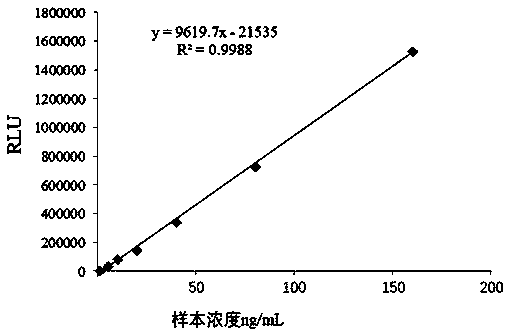Glass capillary surface antibody fixing method
A technology of glass capillary and immobilization method, which is applied in the direction of carrier binding/immobilization of peptides, chemical instruments and methods, and specific peptides. Safe antibody immobilization, effect of improving hydrophilicity
- Summary
- Abstract
- Description
- Claims
- Application Information
AI Technical Summary
Problems solved by technology
Method used
Image
Examples
Embodiment 1
[0047] A method for immobilizing antibodies on the surface of a glass capillary, characterized in that: comprising the steps of:
[0048] S1: Modification, modifying the surface of the glass capillary;
[0049] S2: Coating the antibody, immobilizing the diluted coating antibody solution on the modified glass capillary;
[0050] S3: Blocking, the antibody-coated glass capillary in S2 is blocked.
[0051] It should be noted that: in S1, the modification treatment is the amination treatment of the glass capillary, and the specific process is as follows:
[0052] a. Keep the glass capillary at 110°C in H 2 Hydroxylation of glass capillary surface in O;
[0053] b. The dendritic polymer PAMAM is gradually bonded to A half-generation PAMAM is obtained on the inner wall of the glass capillary; then the terminal ester group undergoes an amidation reaction with ethylenediamine (EDA) to obtain a whole-generation dendritic macromolecule polyamide-amine (PAMAM), and an aminated glass ...
Embodiment 2
[0102] This example is basically the same as Example 1, except that in S1, the modification treatment is carboxylation treatment of glass capillary, and the specific process is as follows:
[0103] First let the glass capillary in 110 °C H 2 The surface of the glass capillary is hydroxylated in O, and then dihydro-3-[3-(triethoxysilyl)propyl]furan-2,5-dione (TESPSA) reacts with silanol to obtain a carboxyl-terminated Carboxylated glass capillary.
[0104] Below in conjunction with concrete experimental procedure, the present invention is described in further detail:
[0105] a. Keep the glass capillary at 110°C in H 2 Hydroxylation of the surface of the glass capillary in O, the specific steps are as follows:
[0106] (1) Glass capillary preparation: put the glass capillary into a 50ml centrifuge tube (capacity: 300 / tube), and spread the glass capillary vertically in a layer in the centrifuge tube by shaking up and down or with the help of tweezers.
[0107] (2) Hydroxylat...
Embodiment 3
[0114] This example is basically the same as Example 1, except that in S1, the modification treatment is the hydroxylation treatment of the glass capillary, and the specific process is as follows:
[0115] First let the glass capillary in 110 °C H 2 The surface of the glass capillary is hydroxylated in O; then the hydroxyl group is grafted with 3-(2,3 glycidoxy)propyltrimethoxysilane (GPTMS) to obtain the terminal epoxy group, and then the epoxy group is passed through the thioethanol Conversion to hydroxyl groups yields hydroxylated glass capillaries containing dendritic structures.
[0116] Below in conjunction with concrete experimental procedure, the present invention is described in further detail:
[0117] a. Keep the glass capillary at 110°C in H 2 Hydroxylation of the surface of the glass capillary in O, the specific steps are as follows:
[0118] (1) Glass capillary preparation: put the glass capillary into a 50ml centrifuge tube (capacity: 300 / tube), and spread th...
PUM
 Login to View More
Login to View More Abstract
Description
Claims
Application Information
 Login to View More
Login to View More - R&D
- Intellectual Property
- Life Sciences
- Materials
- Tech Scout
- Unparalleled Data Quality
- Higher Quality Content
- 60% Fewer Hallucinations
Browse by: Latest US Patents, China's latest patents, Technical Efficacy Thesaurus, Application Domain, Technology Topic, Popular Technical Reports.
© 2025 PatSnap. All rights reserved.Legal|Privacy policy|Modern Slavery Act Transparency Statement|Sitemap|About US| Contact US: help@patsnap.com



